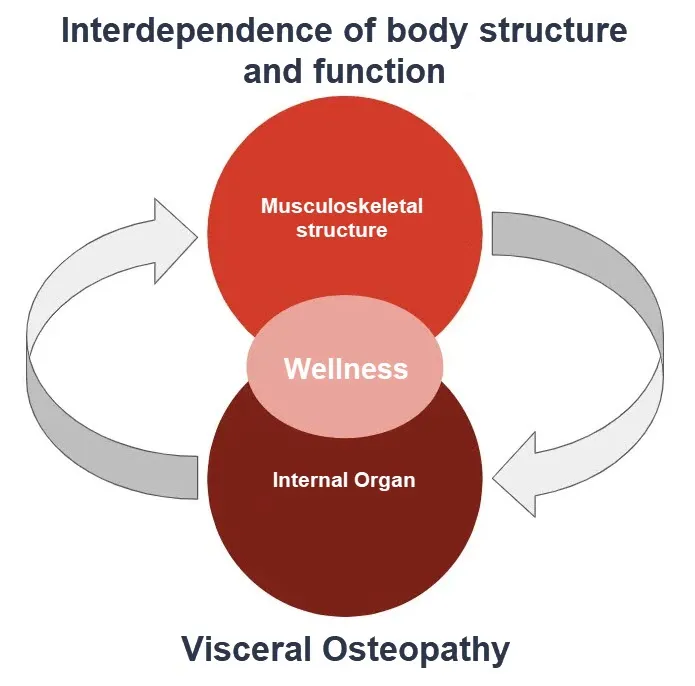Introduction
Visceral osteopathy, as a specialty of osteopathy, is dedicated to the evaluation, diagnosis and treatment of dysfunctions related to the body’s internal organs. Based on the fundamental principle of the interconnectedness of the body as a whole system, this approach recognizes the close connection between musculoskeletal structures and internal organs.
This discipline is based on the principle that internal organs do not function in isolation, but are an integral part of a complex network of tissues, fascia and nerve connections. Thus, visceral osteopathy is not limited to treating only visceral symptoms, but also considers the influence of these dysfunctions on neighboring musculoskeletal structures. It fully recognizes the close connection between the mobility of internal organs and the proper functioning of muscular and bone structures, thus emphasizing the interdependence of the structure and function of the body.
The assessment process in visceral osteopathy involves gentle and specific palpation of the internal organs in order to detect possible movement restrictions, tensions or imbalances. Practitioners use precise manual techniques to restore organ mobility, promote blood and lymphatic circulation, and create an environment conducive to self-healing.
The applications of visceral osteopathy are extensive, covering various conditions such as gastrointestinal disorders, respiratory problems, urogenital dysfunctions, and even stress-related symptoms. Proponents of this approach believe that improving the mobility of internal organs contributes to restoring the overall balance of the body, thus promoting optimal health.
It is important to emphasize that visceral osteopathy does not replace conventional medical treatments, but can be used as a complement to support physical well-being. Collaboration between visceral osteopathic practitioners and conventional healthcare professionals offers comprehensive approaches to improve the overall health of individuals. This integrative approach, combining the strengths of different disciplines, can offer personalized solutions for the well-being of each person. In summary, visceral osteopathy recognizes the close connection between internal organs and musculoskeletal structures, emphasizing its commitment to a holistic approach to physical well-being.
Interdependence of body structure and function
The interconnectedness of body structure and function is a fundamental principle in medicine and health sciences. It is the recognition of the close connection between the way different parts of the body are structured (anatomy) and their ability to function properly (physiology). In other words, the way the body’s organs, tissues, muscles, and systems are arranged directly impacts their ability to perform their specific functions.
This principle emphasizes that optimal health depends on the balance and coordination between anatomical structure on the one hand, and physiological function on the other. For example, well-aligned joints allow for smooth movement, mobile internal organs promote optimal organ function, and healthy muscles facilitate mobility.

The interdependence of structure and function is embedded in many medical disciplines, including physiology, anatomy, kinesiology, and other branches of the health sciences. This means that understanding how different parts of the body are organized is essential to understanding how they work and vice versa.
In summary, the interdependence of structure and function emphasizes that the health and well-being of the human body results from a harmony between the way it is structured and the way it performs its physiological functions. It is a key concept for the overall understanding of the body and its maintenance in a state of health.
History of Visceral Osteopathy
Osteopathy, conceived in the 19th century by Dr Andrew Taylor Still, has evolved over time to embrace various specialties, including visceral osteopathy. The history of this fascinating medical practice dates back to its roots, where Dr. Still’s central vision was based on the belief that the human body possesses an intrinsic capacity to self-heal and self-regulate.
In its early days, osteopathy focused primarily on the musculoskeletal system, exploring how dysfunctions in this region could affect the overall health of the body. However, as osteopathy developed, it broadened its scope to include internal organs, giving rise to visceral osteopathy.
The fundamental idea of visceral osteopathy is based on the notion that the body’s internal organs are interconnected and that any imbalance in this dynamic can influence overall health. Practitioners of visceral osteopathy use specific manual techniques to assess and treat internal organs, promoting free flow of fluids and structural balance.
A captivating anecdote in the history of visceral osteopathy highlights Dr. Still’s insight into understanding the human body. It is reported that one day, while treating a patient with chronic back pain, Dr. Still found that the source of the problem lay not in the spine, but rather in an imbalance in the internal organs. . By applying gentle and precise manipulations, he was able to significantly relieve the patient’s symptoms. This episode marks a turning point in the development of visceral osteopathy, demonstrating the ability of this approach to identify and treat the root causes of health problems.
Today, visceral osteopathy continues to evolve, drawing on in-depth anatomical knowledge and scientific advances. Modern practitioners of this discipline seek to understand the complex connections between internal organs, musculoskeletal structures and the nervous system, offering holistic care focused on restoring the body’s overall balance.
In conclusion, visceral osteopathy represents an intriguing facet of osteopathy that emerged from the innovative vision of Dr. Still. Its history, marked by key moments such as the anecdote of the treatment of back pain, testifies to its ability to adapt and evolve to better understand and treat the complex mechanisms of the human body. This discipline continues to offer unique perspectives on health and well-being, placing its history at the heart of the evolution of medical practices.
Fundamental principles
Visceral osteopathy is based on fundamental principles that highlight a holistic approach to the body and its internal functions. First of all, this discipline considers the normal mobility of organs as an essential component to guarantee their optimal function. Practitioners believe that restrictions in movement can lead to imbalances and dysfunction, thereby affecting the patient’s overall health. By focusing on restoring organic mobility, visceral osteopathy aims to promote harmonious balance in the body.
A second key principle of visceral osteopathy lies in the recognition of the importance of vascularization and innervation of organs. The blood vessels and nerves that supply organs are closely linked to their optimal functioning. Any imbalance in these circulatory and nervous systems can have detrimental consequences on organ health. Practitioners therefore seek to assess and correct possible vascular and nervous dysfunctions to promote the health of internal organs.
Finally, the holistic approach of visceral osteopathy highlights the importance of evaluating the body as a whole. Practitioners not only examine organs individually, but also consider their relationship to surrounding structures. This includes fascia, the connective tissues that wrap and support organs, as well as muscles and joints. Understanding these relationships allows practitioners to detect more subtle imbalances and take a comprehensive approach to treating patients.
In the history of visceral osteopathy, a striking example highlights these principles. A patient complained of persistent abdominal pain without any organic cause being identified by traditional medical examinations. Using the holistic approach of visceral osteopathy, the practitioner assessed the mobility of the abdominal organs, identifying movement restrictions in the liver and intestines. By correcting these restrictions through gentle manipulation, the patient saw a significant improvement in his symptoms. This anecdote illustrates the relevance of visceral osteopathy in the detection and correction of subtle dysfunctions that may escape conventional medical methods.
In conclusion, the fundamental principles of visceral osteopathy highlight a complete approach to the body, considering organic mobility, vascularization, and innervation as interdependent elements. This discipline continues to evolve, building on these principles to provide personalized care aimed at restoring the body’s overall balance and promoting lasting health.
Treatment Techniques
Visceral osteopathy, as a specialty of osteopathy, is dedicated to the evaluation, diagnosis and treatment of dysfunctions related to the body’s internal organs. Based on the fundamental principle of the interconnectedness of the body as a whole system, this approach recognizes the close connection between musculoskeletal structures and internal organs.
This discipline is based on the principle that internal organs do not function in isolation, but are an integral part of a complex network of tissues, fascia and nerve connections. Thus, visceral osteopathy is not limited to treating only visceral symptoms, but also considers the influence of these dysfunctions on neighboring musculoskeletal structures. It fully recognizes the close connection between the mobility of internal organs and the proper functioning of muscular and bone structures, thus emphasizing the interdependence of the structure and function of the body.
Visceral osteopaths use a wide range of techniques to assess and treat visceral dysfunction. The evaluation often begins with a thorough history, allowing the practitioner to gather information about the patient’s medical history, current symptoms, and lifestyle.
Then, the visceral osteopath uses manual techniques to assess the mobility of the internal organs. These techniques may include gentle palpations, specific movements, and targeted manipulations to restore normal organ mobility. It is important to emphasize that these manipulations are carried out with delicacy and precision, while respecting the comfort of the patient.
This holistic approach allows the visceral osteopath to treat dysfunctions at the source, by considering the body as a whole. By restoring the mobility of internal organs, visceral osteopathy aims to promote better blood, lymphatic and nervous circulation, thus creating an environment conducive to self-healing.
It is important to emphasize that visceral osteopathy does not replace conventional medical treatments, but can be used as a complement to support physical well-being. Collaboration between visceral osteopathic practitioners and conventional healthcare professionals offers comprehensive approaches to improve the overall health of individuals. In summary, visceral osteopathy recognizes the close connection between internal organs and musculoskeletal structures, thus committing to addressing imbalances in an integrative and personalized manner for the optimal well-being of each individual.
Clinical Applications
Visceral osteopathy is proving to be a versatile therapeutic approach, applied in the treatment of a variety of disorders. It is particularly effective in relieving gastrointestinal problems, including functional disorders, abdominal pain and digestion problems. This discipline is also useful in the treatment of urinary problems, as well as in the management of respiratory conditions.
Gastrointestinal disorders, such as functional disorders, can benefit from visceral osteopathy due to its holistic approach that aims to restore mobility to internal organs. Abdominal pain, often linked to visceral tensions, can be reduced thanks to specific techniques of visceral osteopathy. Likewise, digestion problems can be addressed by addressing any mobility restrictions in the organs involved in the digestive process.
Urinary problems, such as interstitial cystitis or bladder function disorders, can also be treated by visceral osteopathy. By working on the mobility of the organs involved in the urinary system, practitioners aim to improve functionality and reduce associated symptoms.
In the respiratory area, visceral osteopathy can be integrated to help relieve conditions such as asthma or breathing disorders. By promoting the mobility of the thoracic organs and improving respiratory mechanics, it helps optimize pulmonary function.
Beyond the physiological aspects, practitioners believe that visceral osteopathy can play an essential role in stress management. By restoring balance to the visceral system, this approach can positively influence the autonomic nervous system. By promoting a more adaptive stress response, it helps alleviate the negative effects of chronic stress on the body and mind.
However, it is important to emphasize that visceral osteopathy does not replace conventional medical treatments. Rather, it can be integrated as a complement, providing a holistic and personalized approach to promote overall well-being. Collaboration between visceral osteopathy practitioners and conventional health professionals can thus offer comprehensive solutions for individuals seeking to improve their physical and emotional health.
Training of Visceral Osteopaths
Visceral osteopaths undergo extensive and rigorous training that encompasses in-depth study of anatomy and physiology, as well as the acquisition of skills specific to visceral osteopathy. This training aims to develop among practitioners a detailed understanding of organ mobility and to teach them the application of precise manual techniques to restore balance in the visceral system.
The in-depth study of anatomy and physiology constitutes the basis of the training of visceral osteopaths. They gain detailed knowledge of the structure and function of internal organs, as well as their interrelationship with surrounding musculoskeletal structures. This anatomical expertise allows visceral osteopaths to identify possible mobility restrictions or tensions at the organ level, thus forming the basis of their therapeutic approach.
The central part of the training of visceral osteopaths focuses on learning techniques specific to visceral osteopathy. These techniques include gentle palpations, specific movements and targeted manipulations aimed at assessing and restoring normal organ mobility. Practitioners are trained to adapt these techniques according to the specific needs of each patient, thus ensuring an individualized approach that respects the patient’s comfort.
The training of visceral osteopaths also incorporates a significant practical component, where practitioners gain expertise in the application of learned techniques. They are guided to develop their palpatory sensitivity in order to subtly perceive tensions and restrictions at the organ level. This essential skill allows them to personalize their therapeutic approach based on the unique needs of each individual.
In summary, visceral osteopath training combines a thorough understanding of anatomy and physiology with practical skills specific to visceral osteopathy. It aims to train professionals capable of assessing and treating visceral dysfunctions in a precise and individualized manner, thus contributing to the overall well-being of patients.
Conclusion
In conclusion, visceral osteopathy embodies a holistic approach to treatment focused on restoring balance and mobility to internal organs. Although the effectiveness of this practice may vary from one individual to another, many patients report significant improvements in their well-being following visceral osteopathy sessions. This therapeutic approach seeks to treat the root causes of symptoms by assessing and correcting dysfunctions at the organ level, thus promoting lasting improvement in health.
Before opting for visceral osteopathy, it is strongly recommended to consult a qualified health professional. A thorough discussion of your symptoms, medical history and specific concerns will help establish whether visceral osteopathy is an appropriate option to meet your specific needs. Health professionals can collaborate with visceral osteopathy practitioners to ensure an integrated and comprehensive approach to patient well-being.
It is also important to emphasize that visceral osteopathy is often part of a complementary care setting and does not replace conventional medical treatments when these are necessary. Open communication between the patient, healthcare professionals and visceral osteopathy practitioners helps ensure a holistic approach to health, integrating different aspects of physical and emotional well-being.
In summary, although visceral osteopathy can offer significant benefits for certain individuals, a personalized approach and informed decision-making in collaboration with qualified health professionals remains essential. By exploring this therapeutic avenue with discernment and taking into account medical advice, it is possible to discover the potential benefits of visceral osteopathy to promote better health and quality of life.

























